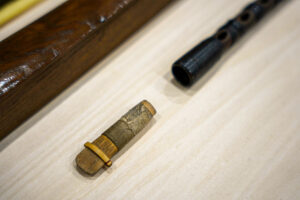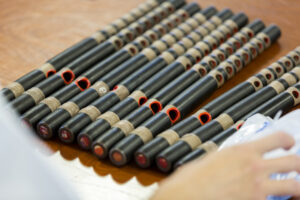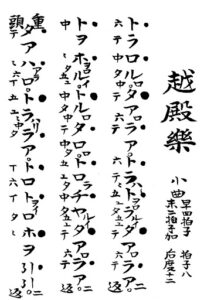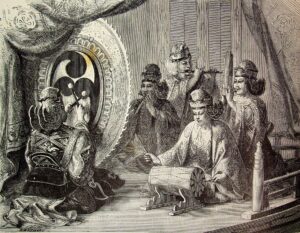
Gagaku is ceremonial music played at court, and was introduced to Japan from China and the Korean peninsula around the 5th century. Gagaku music can be broadly divided into instrumental music (kangen) and bugaku (bugaku), which includes dances. There are also "Saibaraku," "Imayo," and "Roei," which are based on ancient Japanese folk songs and have lyrics.
In 894, the Tang Dynasty envoys to China were abolished and music imports from the continent ceased, but music and dance from China and the Korean peninsula were fused with music and dance from even earlier times and Japanized. A rough form was established during the Heian period (794-1185), which has been handed down to the present day.

The original can be traced back to the Nara period. Instruments from that period remain in the Shosoin Repository in Nara, and they are more than 1,000 years old. As you know, Shosoin is home to many other valuable items besides musical instruments, and some of them are exhibited to the public at the Shosoin Exhibition held in autumn. Some of the instruments may also be seen.
As a side note, I once had a conversation with a Gagaku performer who brought an old instrument with him, and when I told him that it looked old and valuable, he said, "It's not that old, it's from the Muromachi period. I thought to myself, "Even in the Muromachi period, it is an old enough instrument.

In Gagaku, those accompanied by Tangaku (Chinese traditional music) are called "left side" and those accompanied by Koma-gaku (Korean traditional music) are called "right side". The right or left side can be distinguished by the costumes. The left side is red and the right side is green. When the dancers appear on stage, the left side dancers appear from the left behind the stage, while the right side dancers appear from the right behind the stage.

Since Gagaku is ceremonial music, it is often performed at temples and shrines as well as at the court. The court in Kyoto, Kofukuji Temple in Nara, and Shitennoji Temple in Osaka became three large groups of performers, known as the "Sanpo-gakusho. They preserved the tradition throughout the Kamakura, Muromachi, and Edo periods.
In the Meiji era (1868-1912), the Emperor's family moved to Tokyo, and the musicians of the three schools moved to Tokyo and became affiliated with the Gagaku Bureau of the Imperial Household Agency (then the Ministry of the Imperial Household). The music of the three traditional schools was compiled into "Meiji-senjohu," which unified the music of each of the three schools.
The pieces included in the "Meiji-senjeongbu" and currently performed are called "current pieces," and include 103 pieces of Tangak and 32 pieces of Koryogak.

The instruments used today are the sho (sho), hichiriki (hichiriki), ryuteki (dragon flute), koma-bue (koma flute), kagura-bue (kagura flute), chukan (middle pipe), raku-daiko or daiko (large taiko), shoko or daigongiko, kakko or san-no-tsuiko, raku-biwa (music biwa), raku koto or wagon. Other instruments used are the shakuboshi (scepter and clapper).
There are other instruments used in the Shosoin that have been restored. ChatGPT The restored instruments include the genkan, hitsu, kugo, sho, u, oohichiriki, houkyou, and ken.
Currently, the Gagaku Department of the Imperial Household Agency has become the Shikibu Shigaku Department of the Imperial Household Agency, and Gagaku of the Shikibu Shigaku Department is designated as an Important Intangible Cultural Property and also as a UNESCO Intangible Cultural Heritage. Shikibu Shigakubu performers are trained not only in Gagaku, but also in the right or left side of the dance, and are in charge of Western music performed in connection with the Imperial Household Agency. In Gagaku, the person in charge of the dragon flute is in charge of the flute, the person in charge of the Hichichiriki is in charge of the clarinet, and so on.

Gagaku is ceremonial music, so we still play it for court events. In most ceremonies, there are no guests, so the music is really performed only for the gods. I have heard from a former member of the Imperial Household Agency's ceremonial music department that some ceremonies are performed throughout the night. It is such a luxury that only those who bring firewood to keep the fire going can listen to it.
There were not many opportunities for the general public to hear gagaku, but the National Theatre of Japan, which opened in 1966, began holding annual gagaku performances, which helped to popularize gagaku. Gagaku performances are so popular that the large theater (1,610 seats) is filled to capacity. Performances using restored instruments are also held at the National Theatre. The Ono Gagaku Kai at Onoterusaki Shrine and Tenrikyo also have a long history of Gagaku performances.
In addition, the gagaku performance group Reigakusha, founded in 1985 by the late Mr. Sukeyasu Shiba, a former member of the ceremonial music department of the Imperial Household Agency, for the purpose of ensemble study of gagaku, holds various concerts and provides many opportunities to listen to gagaku music.
Hideki Togi started appearing on TV with Hichiriki, which may have helped to spread Gagaku to many people. In case you are wondering, Hideki Togi used to be a member of the Imperial Household Agency's ceremonial music department. He used to play the cello when performing Western music.
The National Theatre of Japan is currently closed for reconstruction, but the bidding process did not go well and the construction schedule is expected to be delayed significantly. For the sake of research and presentation of Gagaku, we are hoping for an early resolution to this problem. Since the National Theatre of Japan will hold its sponsored events in other halls while it is closed, Gagaku performances will probably be held somewhere else.
The general public also has a chance to go to a Gagaku (traditional Japanese court music) concert at the Imperial Palace. In the spring, cultural groups and diplomatic missions in Japan are invited to attend for three days, and in the fall, for those from the general public who wish to attend, Gagaku concerts are held for three days between late October and early November at the Gakubu in the Imperial Palace, usually publicized through newspapers and radio programs. It is recommended that you check the website frequently.

When I was making a Gagaku CD and checking the heads of the pieces, I was very much indebted to Mr. Sukeyasu Shiba, the supervisor of the CD. In Gagaku, before starting a piece of music, we do something called "natori," which is a kind of tuning. It is the same as the way an orchestra first tunes the A note. Since the "ondori" sounds like a part of the piece, I once laughed and said, "You can't do an intro quiz with gagaku music.
Tune, as I said, Japan also has sound names like Doremi. They are ichikotsu, dankin, hyojo, shozetsu, shimomu, sosho, fusho, oshiki, rankei, banshiki, shinsen, and kamimu. Gagaku is played together in these tones. If the piece is in the ichigoe key, the "ichigoe ondori" is played before the piece. Ichigoe is in D, and from there it goes up a semitone.
Gagaku has a 1,300-year history, and its costumes are gorgeous, and it is a music that takes us to a different world from the one we are used to, just like the music of the court.